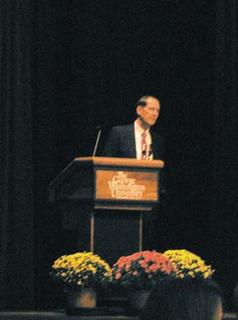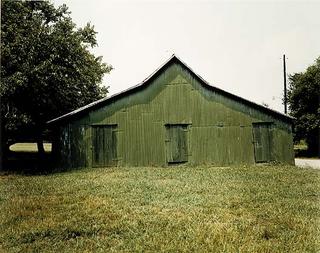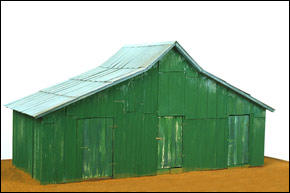Clarice Smith Lecture
 This is why you should always subscribe to museum's e-mail lists and check their Web sites regularly. As recommended here a couple weeks ago, I showed up Wednesday night at Lisner Auditorium, expecting to hear James Rosenquist give the first Clarice Smith Distinguished Lecture in American Art, hosted by the Smithsonian American Art Museum every year. (Last year, I also caught the first one, an excellent talk given by The New Yorker's art critic, Peter Schjeldahl.) Well, James Rosenquist was indisposed and could not come to Washington, so at the last minute William Christenberry, professor at the Corcoran College of Art + Design, stepped in to speak about his art. This was a nice look into the future, since Christenberry is preparing a major retrospective of his work, which will reopen the SAAM next summer.
This is why you should always subscribe to museum's e-mail lists and check their Web sites regularly. As recommended here a couple weeks ago, I showed up Wednesday night at Lisner Auditorium, expecting to hear James Rosenquist give the first Clarice Smith Distinguished Lecture in American Art, hosted by the Smithsonian American Art Museum every year. (Last year, I also caught the first one, an excellent talk given by The New Yorker's art critic, Peter Schjeldahl.) Well, James Rosenquist was indisposed and could not come to Washington, so at the last minute William Christenberry, professor at the Corcoran College of Art + Design, stepped in to speak about his art. This was a nice look into the future, since Christenberry is preparing a major retrospective of his work, which will reopen the SAAM next summer.
Christenberry has lived here in Washington since 1968, but his art is all about the place where he was born and grew up, Tuscaloosa and its surroundings, Hale County, Alabama. With slides, the artist led us through the development of his works, beginning with the Christmas present he and his sister received in 1944, a Kodak Brownie camera. He started to take pictures with it as he wandered around the countryside (which is what kids used to do before they had to wear helmets everywhere) and had them processed at the local drugstore into 3-by-5-inch prints. We saw beautiful, plain, squarely framed photographs of southern country churches, tenant houses, and other "vernacular architecture," as Christenberry put it. They were so apparently ordinary that he was afraid even to show them to the photographer Walker Evans, whom Christenberry met when he moved to New York. Far from being underwhelmed, Evans suggested that Christenberry had found, with his simple camera, a "natural extension of his eye."
 |  |
What he discovered with the camera is that things he saw haunted him, and he could capture those images, but the snapshot was only the first step in the process of possession. Soon he began to return to the same sites in Hale County every year to create series of photographs. In photographs taken years apart, we saw a tiny cabin become engulfed by kudzu and a country store fall into total dilapidation. Then he began to make paintings based on the photographs (we saw a couple examples in an abstract expressionist style) and to make detailed sculptures of the buildings like miniature models. One such pair of photograph and sculpture, of a green warehouse in Newbern, Alabama, is shown here. The final step was actually to possess things that obsessed his eye. Christenberry told us about how he came to acquire a homemade cross left in a cemetery, a wooden palmist's sign (upside down), and an enormous sign depicting an ear of corn. These things now hang in his studio.
The remaining two Clarice Smith lectures will be given by Roberta Smith, art critic of the New York Times (Between a Rock and a Hard Place: Art Criticism, Art Theory and the Art Market, October 5), and art historian Wanda M. Corn (Telling Tales: Georgia O'Keeffe as Autobiographer, November 2). Both lectures will begin at 7 pm, in Lisner Auditorium.





















































No comments:
Post a Comment